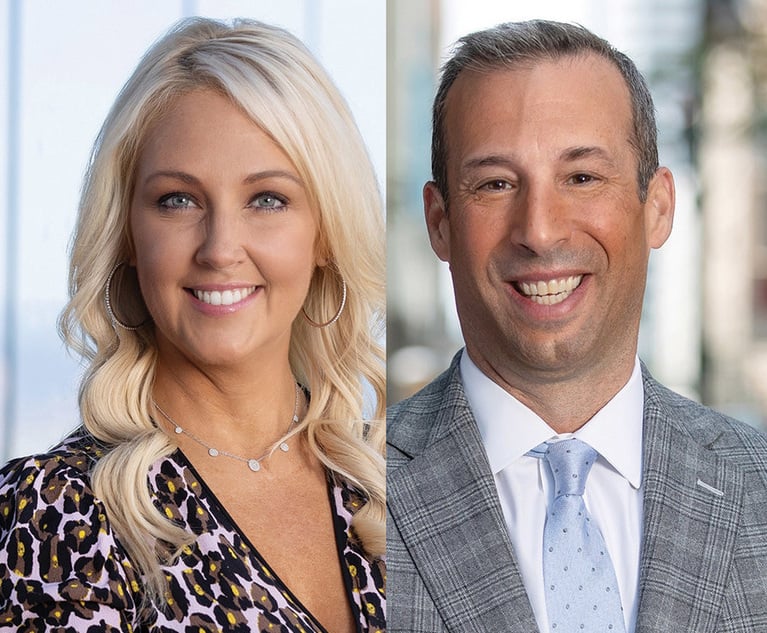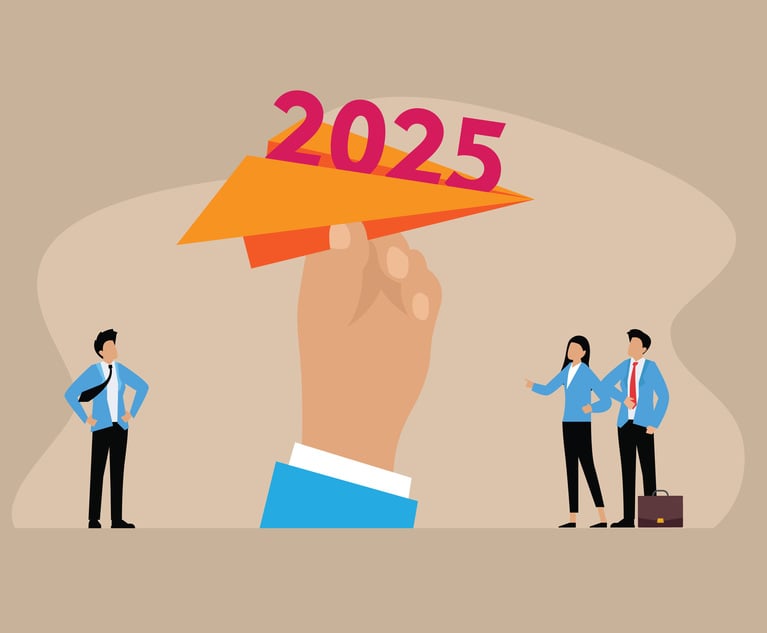 Credit: BillionPhotos.com/Adobe Stock
Credit: BillionPhotos.com/Adobe Stock Fed Set to Target Even Higher Rates for Stubborn Inflation
Several Federal Reserve policymakers have said they want to see a decline in core inflation, a measure excluding volatile food and energy prices, before they slow the pace of interest rate increases.
October 14, 2022 at 02:35 PM
5 minute read
Federal Reserve officials are likely to once again raise their outlook for how high they'll have to lift interest rates following the latest bout of bad inflation news.
Several Fed policymakers have said they want to see a decline in core inflation, a measure excluding volatile food and energy prices, before they slow the pace of rate increases.
But data released Thursday showed the numbers continue to go in the opposite direction, with the core consumer price index climbing 0.6% for a second month and increasing 6.6% from a year ago, the highest level since 1982.
That hardened bets officials will roll out another significant rate hike next month, and could signal they'll need to bring rates higher than they previously expected before they can take a pause. It would be the latest upward revision to estimates for the peak of this tightening cycle as policymakers fight to control price pressures.
All three of their quarterly projections this year have shown a shift higher in the peak rate, starting in March when they began raising borrowing costs from nearly zero. The next forecast publication is mid-December, but officials will have plenty of opportunity between now and then to drive expectations further north.
"They're going to have to go a lot higher," said Steven Blitz, chief U.S. economist for TS Lombard. "The trend that you see in terms of broad-based inflation is that it's not decelerating."
Kansas City Fed President Esther George, San Francisco's Mary Daly and Fed Governor Lisa Cook have the chance to reflect on how the inflation report affects their outlooks when they speak at separate events Friday.
Policymakers last month projected rates rising to around 4.5% and staying there for some time to get inflation on track to return to the Fed's 2% target. With their benchmark rate in a target range of 3% to 3.25%, that implied a downshift in the pace of rate increases in coming months after a string of 75 basis-point moves.
But with core price gains persisting, U.S. central bankers could be signaling by early next year that they're willing to get interest rates as high as 5.5% to get inflation down, Blitz said.
Fed officials point to the economic projections released after their Sept. 20-21 meeting as the best guide for where they see interest rates headed. But they are also careful to say that the forecasts are not a commitment and their views will evolve as they learn more about how the economy is behaving.
"As we go forward, of course we're going to always be looking at what is the incoming data and economic information that we're getting from our contacts telling us about where the economy is headed," Cleveland Fed President Loretta Mester told reporters on Tuesday.
Mester said officials would adjust policy if inflation comes down faster than they anticipated. "On the other hand, if inflation doesn't come down and we see that the pressures are still increasing, then that will help me evaluate where policy is as well," she said.
Policymakers will get October and November consumer price readings before their Dec. 13-14 policy meeting.
If history is any guide, officials could forecast a higher terminal rate when they meet in December. A look at officials' previous projections shows they have raised their expectations for how high they think rates will need to go with each update this year.
Six of the Fed's 19 policymakers forecast the upper boundary of their target range for rates would reach 5% next year, according to estimates published in September. But in June, the highest projection called for a target range with an upper bound of 4.5% in 2023, and only one Fed official penciled that in. In March, the most hawkish officials saw rates reaching an upper bound of 3.75% next year.
The evolution of the Fed's "dot plot," as its known, illustrates how much officials have ramped up their efforts in the wake of surprisingly strong inflation. And with no relief in sight, Fed watchers say the central bank is likely to keep making big moves.
Investors expect Fed officials to raise rates by 75 basis points for the fourth straight time when they meet in early November with the same-sized move on the table for December, continuing the most aggressive tightening cycle since the 1980s.
With the unemployment still low, the latest inflation reading suggests Fed officials may need to raise rates closer to 5% before they can pause, said Tiffany Wilding, North America economist for Pacific Investment Management Co.
The Fed could consider slowing down or stopping the hikes next year if the U.S. unemployment rate moves up and the economy contracts, she said. However, she said it would take significant labor market weakness for the Fed to back down.
Fed officials saw the jobless rate rising to 4.4% by the end of next year, according to the projections they released in September. It was 3.5% last month.
But Wilding said the rate may need to rise more, closer to 5%, for inflation to come down significantly.
"The Fed frankly needs to see some labor market weakness in order to be more assured that inflation's going to come down," she said.
Jonnelle Marte reports for Bloomberg News.
NOT FOR REPRINT
© 2025 ALM Global, LLC, All Rights Reserved. Request academic re-use from www.copyright.com. All other uses, submit a request to [email protected]. For more information visit Asset & Logo Licensing.
You Might Like
View All

Special Counsel Jack Smith Prepares Final Report as Trump Opposes Its Release
4 minute read
These Law Firm Leaders Are Optimistic About 2025, Citing Deal Pipeline, International Business
6 minute read
'Serious Disruptions'?: Federal Courts Brace for Government Shutdown Threat
3 minute readLaw Firms Mentioned
Trending Stories
Who Got The Work
Michael G. Bongiorno, Andrew Scott Dulberg and Elizabeth E. Driscoll from Wilmer Cutler Pickering Hale and Dorr have stepped in to represent Symbotic Inc., an A.I.-enabled technology platform that focuses on increasing supply chain efficiency, and other defendants in a pending shareholder derivative lawsuit. The case, filed Oct. 2 in Massachusetts District Court by the Brown Law Firm on behalf of Stephen Austen, accuses certain officers and directors of misleading investors in regard to Symbotic's potential for margin growth by failing to disclose that the company was not equipped to timely deploy its systems or manage expenses through project delays. The case, assigned to U.S. District Judge Nathaniel M. Gorton, is 1:24-cv-12522, Austen v. Cohen et al.
Who Got The Work
Edmund Polubinski and Marie Killmond of Davis Polk & Wardwell have entered appearances for data platform software development company MongoDB and other defendants in a pending shareholder derivative lawsuit. The action, filed Oct. 7 in New York Southern District Court by the Brown Law Firm, accuses the company's directors and/or officers of falsely expressing confidence in the company’s restructuring of its sales incentive plan and downplaying the severity of decreases in its upfront commitments. The case is 1:24-cv-07594, Roy v. Ittycheria et al.
Who Got The Work
Amy O. Bruchs and Kurt F. Ellison of Michael Best & Friedrich have entered appearances for Epic Systems Corp. in a pending employment discrimination lawsuit. The suit was filed Sept. 7 in Wisconsin Western District Court by Levine Eisberner LLC and Siri & Glimstad on behalf of a project manager who claims that he was wrongfully terminated after applying for a religious exemption to the defendant's COVID-19 vaccine mandate. The case, assigned to U.S. Magistrate Judge Anita Marie Boor, is 3:24-cv-00630, Secker, Nathan v. Epic Systems Corporation.
Who Got The Work
David X. Sullivan, Thomas J. Finn and Gregory A. Hall from McCarter & English have entered appearances for Sunrun Installation Services in a pending civil rights lawsuit. The complaint was filed Sept. 4 in Connecticut District Court by attorney Robert M. Berke on behalf of former employee George Edward Steins, who was arrested and charged with employing an unregistered home improvement salesperson. The complaint alleges that had Sunrun informed the Connecticut Department of Consumer Protection that the plaintiff's employment had ended in 2017 and that he no longer held Sunrun's home improvement contractor license, he would not have been hit with charges, which were dismissed in May 2024. The case, assigned to U.S. District Judge Jeffrey A. Meyer, is 3:24-cv-01423, Steins v. Sunrun, Inc. et al.
Who Got The Work
Greenberg Traurig shareholder Joshua L. Raskin has entered an appearance for boohoo.com UK Ltd. in a pending patent infringement lawsuit. The suit, filed Sept. 3 in Texas Eastern District Court by Rozier Hardt McDonough on behalf of Alto Dynamics, asserts five patents related to an online shopping platform. The case, assigned to U.S. District Judge Rodney Gilstrap, is 2:24-cv-00719, Alto Dynamics, LLC v. boohoo.com UK Limited.
Featured Firms
Law Offices of Gary Martin Hays & Associates, P.C.
(470) 294-1674
Law Offices of Mark E. Salomone
(857) 444-6468
Smith & Hassler
(713) 739-1250






